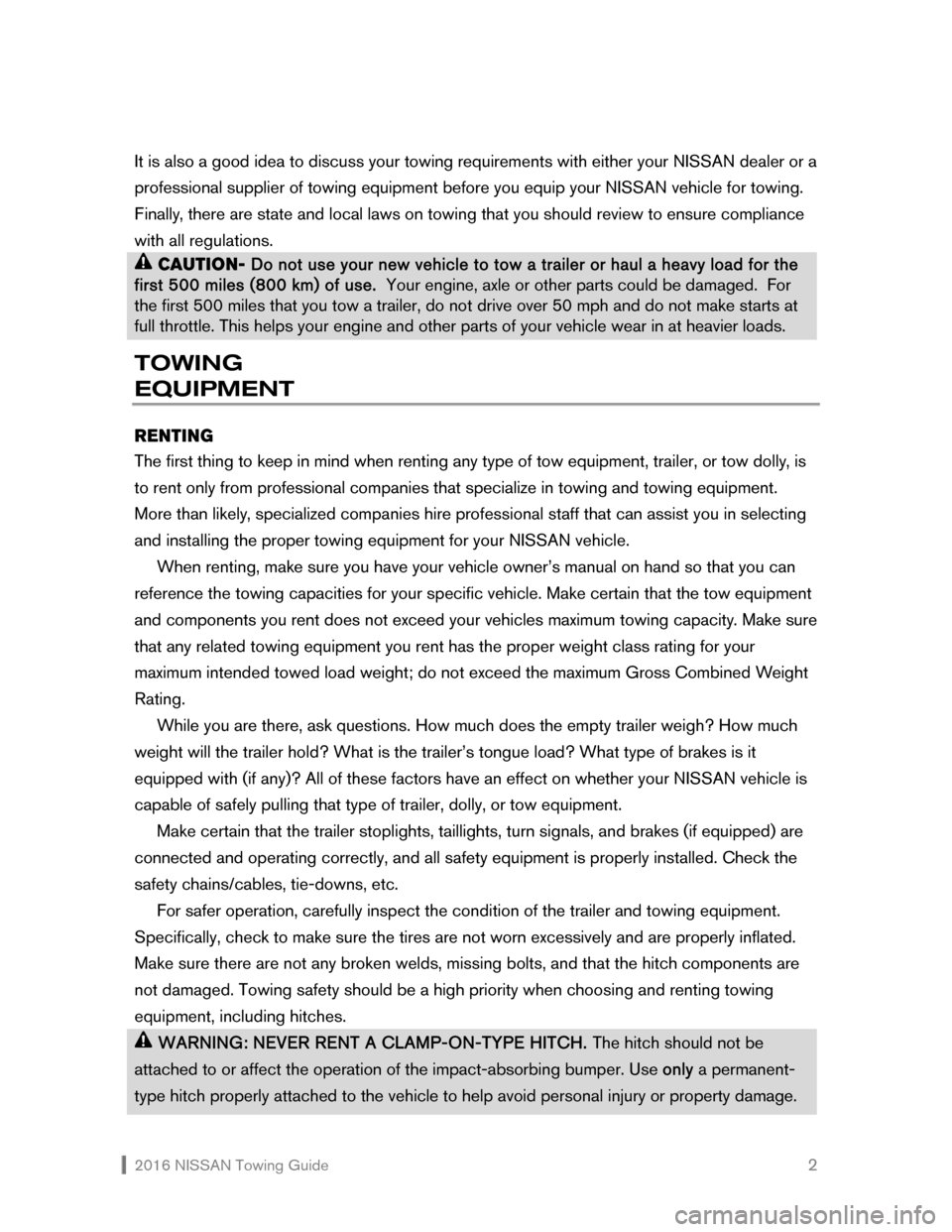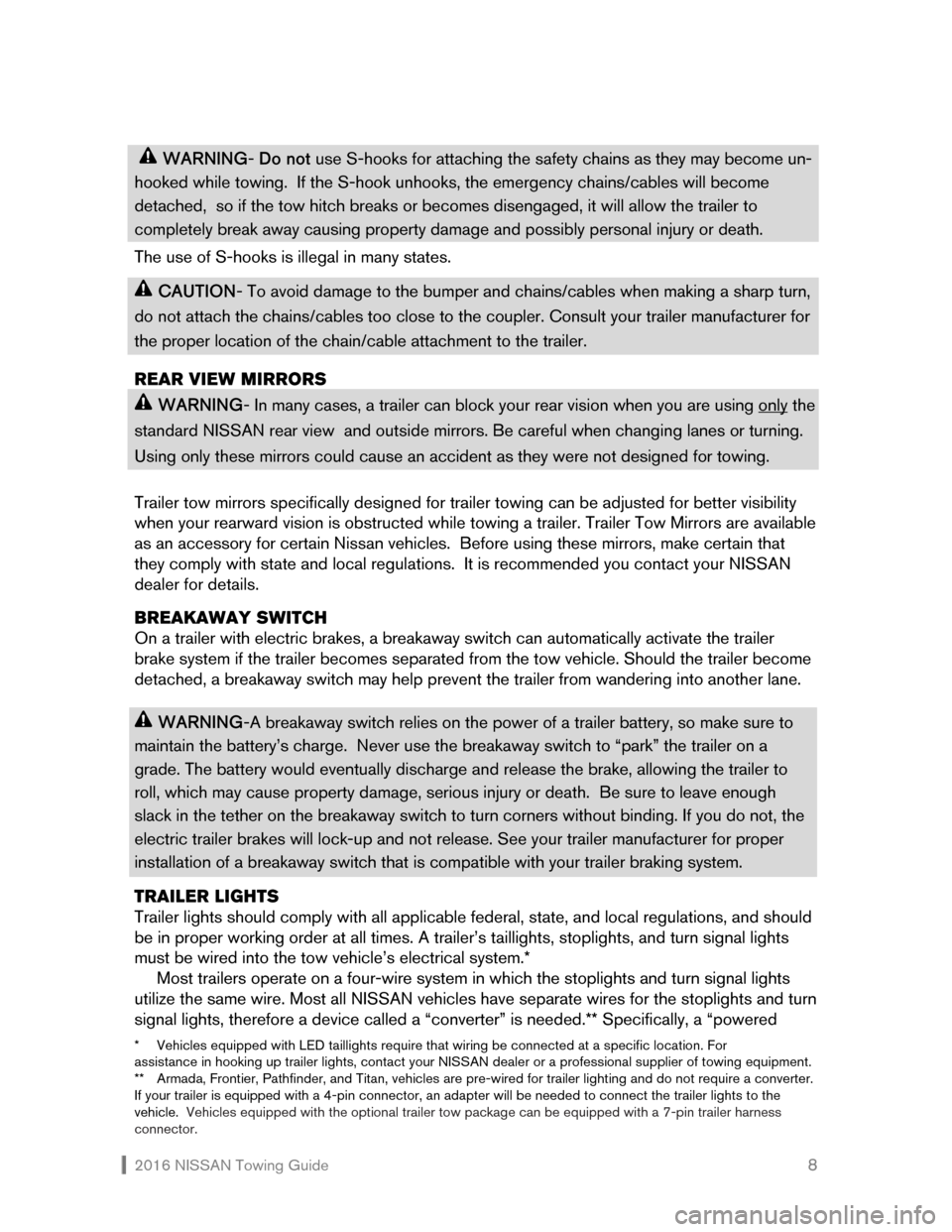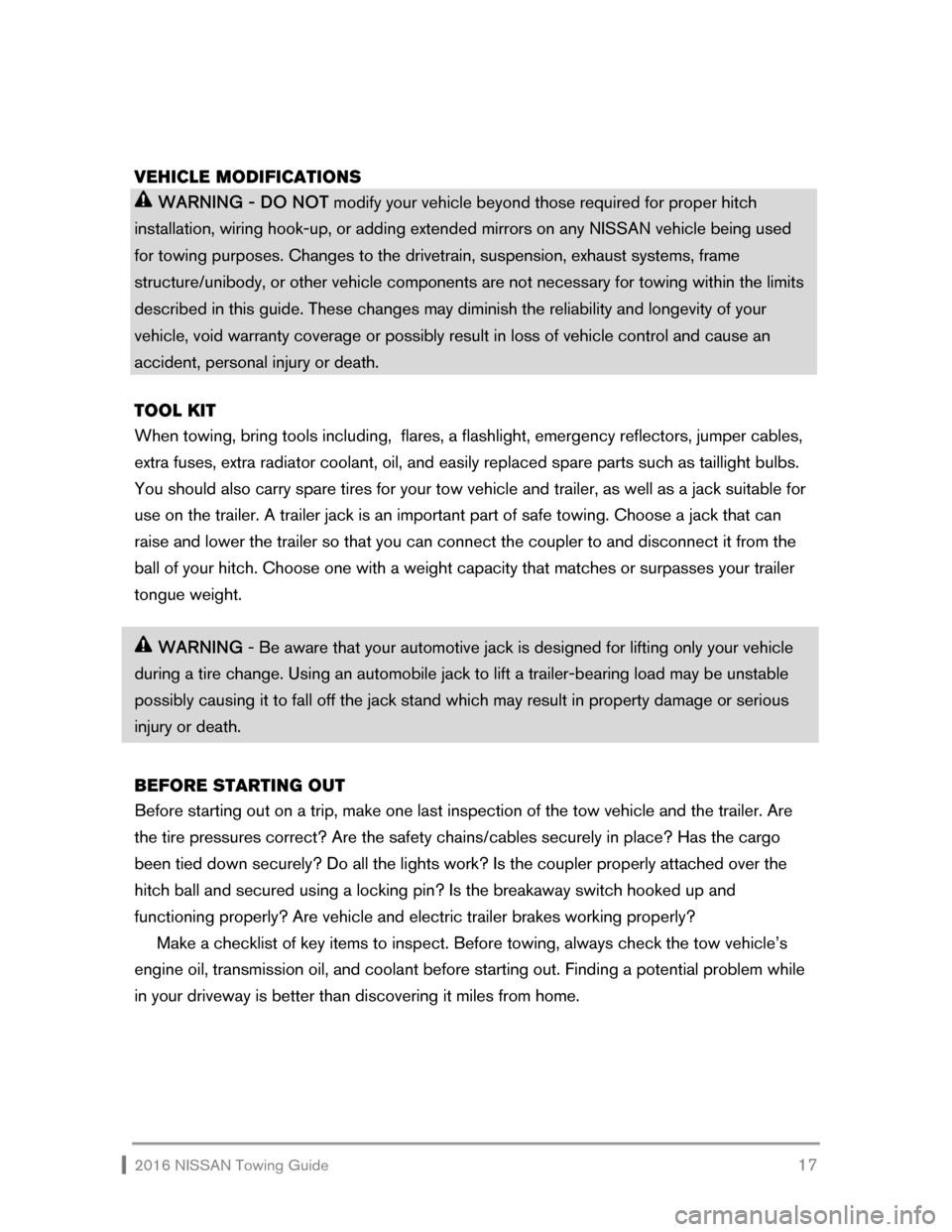warning lights NISSAN 370Z ROADSTER 2016 Z34 Towing Guide
[x] Cancel search | Manufacturer: NISSAN, Model Year: 2016, Model line: 370Z ROADSTER, Model: NISSAN 370Z ROADSTER 2016 Z34Pages: 27, PDF Size: 0.55 MB
Page 3 of 27

2016 NISSAN Towing Guide 2
It is also a good idea to discuss your towing requirements with either your NISSAN dealer or a
professional supplier of towing equipment before you equip your NISSAN vehicle for towing.
Finally, there are state and local laws on towing that you should review to ensure compliance
with all regulations.
CAUTION- Do not use your new vehicle to tow a trailer or haul a heavy load for the
first 500 miles (800 km) of use. Your engine, axle or other parts could be damaged. For
the first 500 miles that you tow a trailer, do not drive over 50 mph and do not make starts at
full throttle. This helps your engine and other parts of your vehicle wear in at heavier loads.
TOWING
EQUIPMENT
RENTING
The first thing to keep in mind when renting any type of tow equipment, trailer, or tow dolly, is
to rent only from professional companies that specialize in towing and towing equipment.
More than likely, specialized companies hire professional staff that can assist you in selecting
and installing the proper towing equipment for your NISSAN vehicle.
When renting, make sure you have your vehicle owner’s manual on hand so that you can
reference the towing capacities for your specific vehicle. Make certain that the tow equipment
and components you rent does not exceed your vehicles maximum towing capacity. Make sure
that any related towing equipment you rent has the proper weight class rating for your
maximum intended towed load weight; do not exceed the maximum Gross Combined Weight
Rating.
While you are there, ask questions. How much does the empty trailer weigh? How much
weight will the trailer hold? What is the trailer’s tongue load? What type of brakes is it
equipped with (if any)? All of these factors have an effect on whether your NISSAN vehicle is
capable of safely pulling that type of trailer, dolly, or tow equipment.
Make certain that the trailer stoplights, taillights, turn signals, and brakes (if equipped) are
connected and operating correctly, and all safety equipment is properly installed. Check the
safety chains/cables, tie-downs, etc.
For safer operation, carefully inspect the condition of the trailer and towing equipment.
Specifically, check to make sure the tires are not worn excessively and are properly inflated.
Make sure there are not any broken welds, missing bolts, and that the hitch components are
not damaged. Towing safety should be a high priority when choosing and renting towing
equipment, including hitches.
WARNING: NEVER RENT A CLAMP-ON-TYPE HITCH. The hitch should not be
attached to or affect the operation of the impact-absorbing bumper. Use only a permanent-
type hitch properly attached to the vehicle to help avoid personal injury or property damage.
Page 9 of 27

2016 NISSAN Towing Guide 8
WARNING- Do not use S-hooks for attaching the safety chains as they may become un-
hooked while towing. If the S-hook unhooks, the emergency chains/cables will become
detached, so if the tow hitch breaks or becomes disengaged, it will allow the trailer to
completely break away causing property damage and possibly personal injury or death.
The use of S-hooks is illegal in many states.
CAUTION- To avoid damage to the bumper and chains/cables when making a sharp turn,
do not attach the chains/cables too close to the coupler. Consult your trailer manufacturer for
the proper location of the chain/cable attachment to the trailer.
REAR VIEW MIRRORS
WARNING- In many cases, a trailer can block your rear vision when you are using only the
standard NISSAN rear view and outside mirrors. Be careful when changing lanes or turning.
Using only these mirrors could cause an accident as they were not designed for towing.
Trailer tow mirrors specifically designed for trailer towing can be adjusted for better visibility
when your rearward vision is obstructed while towing a trailer. Trailer Tow Mirrors are available
as an accessory for certain Nissan vehicles. Before using these mirrors, make certain that
they comply with state and local regulations. It is recommended you contact your NISSAN
dealer for details.
BREAKAWAY SWITCH
On a trailer with electric brakes, a breakaway switch can automatically activate the trailer
brake system if the trailer becomes separated from the tow vehicle. Should the trailer become
detached, a breakaway switch may help prevent the trailer from wandering into another lane.
WARNING-A breakaway switch relies on the power of a trailer battery, so make sure to
maintain the battery’s charge. Never use the breakaway switch to “park” the trailer on a
grade. The battery would eventually discharge and release the brake, allowing the trailer to
roll, which may cause property damage, serious injury or death. Be sure to leave enough
slack in the tether on the breakaway switch to turn corners without binding. If you do not, the
electric trailer brakes will lock-up and not release. See your trailer manufacturer for proper
installation of a breakaway switch that is compatible with your trailer braking system.
TRAILER LIGHTS
Trailer lights should comply with all applicable federal, state, and local regulations, and should
be in proper working order at all times. A trailer’s taillights, stoplights, and turn signal lights
must be wired into the tow vehicle’s electrical system.*
Most trailers operate on a four-wire system in which the stoplights and turn signal lights
utilize the same wire. Most all NISSAN vehicles have separate wires for the stoplights and turn
signal lights, therefore a device called a “converter” is needed.** Specifically, a “powered
* Vehicles equipped with LED taillights require that wiring be connected at a specific location. For
assistance in hooking up trailer lights, contact your NISSAN dealer or a professional supplier of towing equipment.
** Armada, Frontier, Pathfinder, and Titan, vehicles are pre-wired for trailer lighting and do not require a converter.
If your trailer is equipped with a 4-pin connector, an adapter will be needed to connect the trailer lights to the
vehicle. Vehicles equipped with the optional trailer tow package can be equipped with a 7-pin trailer harness
connector.
Page 18 of 27

2016 NISSAN Towing Guide 17
VEHICLE MODIFICATIONS
WARNING - DO NOT modify your vehicle beyond those required for proper hitch
installation, wiring hook-up, or adding extended mirrors on any NISSAN vehicle being used
for towing purposes. Changes to the drivetrain, suspension, exhaust systems, frame
structure/unibody, or other vehicle components are not necessary for towing within the limits
described in this guide. These changes may diminish the reliability and longevity of your
vehicle, void warranty coverage or possibly result in loss of vehicle control and cause an
accident, personal injury or death.
TOOL KIT
When towing, bring tools including, flares, a flashlight, emergency reflectors, jumper cables,
extra fuses, extra radiator coolant, oil, and easily replaced spare parts such as taillight bulbs.
You should also carry spare tires for your tow vehicle and trailer, as well as a jack suitable for
use on the trailer. A trailer jack is an important part of safe towing. Choose a jack that can
raise and lower the trailer so that you can connect the coupler to and disconnect it from the
ball of your hitch. Choose one with a weight capacity that matches or surpasses your trailer
tongue weight.
WARNING - Be aware that your automotive jack is designed for lifting only your vehicle
during a tire change. Using an automobile jack to lift a trailer-bearing load may be unstable
possibly causing it to fall off the jack stand which may result in property damage or serious
injury or death.
BEFORE STARTING OUT
Before starting out on a trip, make one last inspection of the tow vehicle and the trailer. Are
the tire pressures correct? Are the safety chains/cables securely in place? Has the cargo
been tied down securely? Do all the lights work? Is the coupler properly attached over the
hitch ball and secured using a locking pin? Is the breakaway switch hooked up and
functioning properly? Are vehicle and electric trailer brakes working properly?
Make a checklist of key items to inspect. Before towing, always check the tow vehicle’s
engine oil, transmission oil, and coolant before starting out. Finding a potential problem while
in your driveway is better than discovering it miles from home.